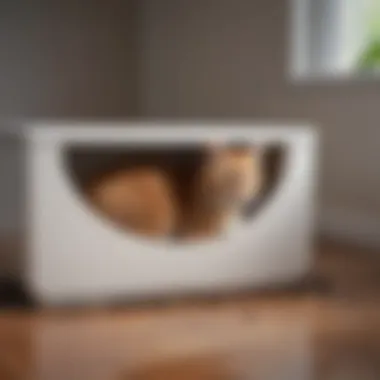Understanding Why Your Cat Won't Use the Litter Box


Intro
The issue of a cat refusing to use the litter box can be alarming for any pet owner. Understanding the intricacies behind this behavior is essential not only for maintaining a clean home but also for ensuring the well-being of the feline companion. The journey begins with careful observation and understanding of the unique factors that may influence your cat's litter box habits.
Pet Care and Grooming
Maintaining regular care for your cat plays a vital role in its overall health and behavior. While many pet owners might focus solely on diet or medical check-ups, grooming is often overlooked. However, it can significantly impact your cat's relationship with its litter box.
Importance of Regular Care
Proper grooming can enhance your cat's comfort and reduce stress. If fur becomes matted or dirty, it may lead to anxiety. Anxiety might cause a cat to avoid the litter box altogether, preferring to relieve itself elsewhere. Regular grooming also aids in tracking any changes in your cat’s skin or fur that could indicate health issues.
Grooming Techniques by Pet Type
Different cats require different grooming techniques. For instance, long-haired breeds such as the Maine Coon benefit from daily brushing. Short-haired cats may need less frequent grooming. Tailoring your grooming strategy helps maintain your cat's comfort, potentially influencing its bathroom habits.
Tools and Products Recommendations
Investing in good grooming tools can make the task easier. Some recommended items include:
- Furminator: Great for reducing shedding in long-haired breeds.
- Soft Bristle Brush: Ideal for short-haired cats and sensitive skin.
- Cat Wipes: Useful for quick clean-ups on the go.
Seasonal Care Tips
During warmer months, increased shedding can lead to fur clumps in the litter box. Maintaining a consistent grooming schedule during this time can help mitigate this issue. Additionally, be mindful of your cat’s hydration, as lack of water intake can also prompt litter box avoidance.
Health and Nutrition
Health and nutrition are fundamental when considering why a cat refuses to use the litter box. Potential health issues might lead to discomfort during urination or defecation, causing avoidance behavior.
Understanding Pet Nutrition
A balanced diet is crucial for maintaining digestive health. Feeding your cat high-quality food that is appropriate for its age and health condition can prevent gastrointestinal problems.
Common Health Issues by Species
Conditions like urinary tract infections or constipation can directly affect a cat’s litter box habits. If your cat suddenly stops using its litter box, a trip to the veterinarian is advisable to rule out any underlying health issues.
Preventive Care and Regular Check-Ups
Regular vet visits can help catch health problems early. These check-ups are fundamental for ensuring that your cat is healthy and to discuss any behavioral concerns you may have.
Food and Dietary Advice
Ensure you provide a diet that includes sufficient moisture. Cats often do not drink enough water; therefore, feeding a mix of dry and wet food can be beneficial. Foods high in fiber can also aid digestive health.
Behavioral Training
Understanding your cat’s behavior is essential to encourage proper litter box usage. Training and positive reinforcement can create a more favorable environment.
Basics of Positive Reinforcement
Instead of punishing undesirable behavior, reward your cat for using the litter box correctly. This could be in the form of treats or affection.
Training Techniques Users Can Apply
Consider placing your cat in the litter box after meals or naps. Associating the litter box with natural behaviors can help reinforce its use.
Managing Behavioral Issues
If your cat is anxious or stressed, identifying triggers such as loud noises or changes in surroundings is critical. Addressing these factors can positively influence litter box habits.


Importance of Socialization
Cats that are not properly socialized may exhibit fearful behavior. Providing gentle exposure to various environments and people can help build confidence.
Engaging Activities and Enrichment
Mental and physical stimulation are important for your cat's overall well-being. Boredom can lead to destructive behavior, including litter box avoidance.
Fun Games to Play with Your Pet
Interactive play can keep your cat engaged. Simple toys like feather wands or laser pointers stimulate hunting instincts and provide exercise.
DIY Toys and Activities
Consider making homemade toys using household items. Cats enjoy exploring and playing with things they find around the house.
Importance of Mental Stimulation
Engaging your cat's mind can prevent boredom. Puzzle feeders or hide-and-seek games provide challenges and keep your cat entertained.
Outdoor Adventures and Exploration
If safe and feasible, supervised outdoor time can provide new experiences. Exploring different environments may reduce stress and improve behavior at home.
Resources and Community Engagement
Finally, engaging with online resources and community support can enhance your knowledge and problem-solving skills.
Recommended Books and Websites
Several books and websites offer valuable information on cat care and behavior. Look for sources that provide evidence-based information and insights.
Forums and Groups for Pet Owners
Joining forums such as Reddit can connect you with other pet owners. Sharing experiences and advice can provide solutions you may not have considered.
Finding Local Services and Classes
Look for local training classes or pet behaviorists who can offer hands-on support. Having professional guidance can facilitate better habits in your cat.
Encouraging Community Sharing and Contributions
Engaging with your community allows for shared experiences and resources. Contributing advice and tips can foster a better environment for all pets and their owners.
Understanding the complex factors surrounding cat behavior is essential for addressing litter box issues effectively.
Prologue to Litter Box Issues
The decision to adopt a cat brings not only companionship but also responsibilities that require awareness and understanding, especially when it comes to litter box behavior. Proper litter box use is a cornerstone of feline care, ensuring hygiene and comfort within the household. However, when a cat refuses to use the litter box, it presents a challenge that can frustrate owners and impact the overall well-being of the pet. Understanding the reasons behind this behavior is crucial for developing effective strategies to encourage better habits.
Importance of the Litter Box
The litter box provides cats with a designated area to relieve themselves, mimicking their instinctual behaviors in a way that is acceptable within a human home. Not only does it fulfill their physical needs, but it also plays a role in their mental health and sense of security. A clean and easily accessible litter box can reduce stress, prevent territorial marking, and promote a harmonious living environment.
Moreover, litter box issues can influence the owner's perception of their pet’s behavior. Recognizing the significance of the litter box may help owners be more empathetic and attentive to their pets’ needs. Understanding that the reluctance to use the box is rarely a behavioral flaw can shift the focus towards identifying underlying causes, fostering a more constructive environment for both the cat and the owner.
Common Misunderstandings
Many pet owners make assumptions about a cat's behavior that can lead to misinterpretation of litter box avoidance. One common misconception is that the cat is being willful or spiteful. In reality, felines do not harbor emotions such as anger or revenge in the same way humans do. Instead, they react to their environment and experiences.
Another misunderstanding involves the expectation that all cats will adapt easily to any type of litter or box setup. Each cat has individual preferences influenced by factors such as their past experiences, health, and even breed. Therefore, owners should not assume that what works for one cat will work for another.


Additionally, some people believe that a dirty litter box is the sole reason for avoidance. While cleanliness is vital, it is not the only factor at play. Issues such as stress, health conditions, and appropriate litter type also need to be considered. By dispelling these misunderstandings, owners can better investigate the behaviors of their cats and address the root causes of litter box reluctance.
Behavioral Reasons for Avoidance
Understanding why cats refuse to use the litter box is crucial for any cat owner. Behavioral reasons can often be overlooked, but they are integral in diagnosing and rectifying the issue. Misinterpretation of a cat’s actions can lead to frustration for both pet and owner. Recognizing these behavioral elements helps create a suitable environment. When addressing these reasons, it is important to be patient and observant. Cats communicate their needs in subtle ways, and subtle behavioral changes can provide valuable insights.
Stress and Anxiety Factors
Cats are sensitive creatures. They may be highly affected by environmental changes, which can result in stress or anxiety. Factors such as loud noises, new family members, or renovations can trigger these reactions. Stress often results in avoidance behaviors. A cat under stress may choose not to enter the litter box, perceiving it as a source of discomfort rather than a safe haven. Creating a calm space can mitigate these feelings. Monitoring your cat's behavior can reveal stress signs, including hiding or excessive grooming.
Territorial Disputes
Territorial instincts play a significant role in your cat's usage of the litter box. Cats are innately territorial, and conflicts with other pets can lead to avoidance. If a cat feels that another animal dominates the litter box area, it may choose to eliminate elsewhere. Understanding their territorial nature helps in creating a harmonious environment. Consider using multiple litter boxes or placing them in distinct areas. This can minimize competition and encourage box use.
Past Traumatic Experiences
Trauma can leave a lasting impact on a cat’s behavior. A negative experience involving the litter box, such as falling into it or being frightened during use, can result in refusal to approach it again. Such experiences are not easily forgotten. If your cat shows signs of anxiety around the litter area, reassessing the situation is essential. Offering a safe alternative, like a different box or location, might assist in overcoming these fears.
Change in Household Dynamics
Changes in household dynamics can deeply affect a cat’s habits. Moving to a new home, the introduction of a new pet, or shifts in family routines can disrupt their sense of security. Cats may respond by rejecting the litter box as part of their response to feeling unsettled. To help your cat adjust to these dynamics, maintaining a consistent routine is key. Providing familiar items, such as a favorite toy or blanket, can also help them transition into the new normal.
Remember: Each cat is unique. Observing their behavior can lead to tailored solutions that meet their specific needs.
Environmental Factors Impacting Use
Understanding environmental factors is crucial. They can directly influence a cat's decision to use the litter box. Owners must pay attention to specific elements that can either encourage or discourage proper litter box behavior. Addressing these factors can lead to effective solutions, improving the bond between pet and owner while fostering a stress-free atmosphere.
Litter Box Location
The placement of the litter box plays a significant role in its usage. Cats are creatures of habit and often desire a specific location that feels safe and accessible. Here are some key considerations:
- Quiet Areas: Cats generally prefer quiet, low-traffic areas away from loud noises or commotion. A sudden loud noise can be frightning, causing them to avoid the box altogether.
- Multiple Boxes: If you have more than one cat, it is wise to provide multiple litter boxes. It helps to ensure that each cat feels they have their own private space.
- Accessibility: The litter box should be easily accessible, especially for elderly cats or those with mobility issues. If a cat struggles to reach the box, it may choose to relieve itself elsewhere.
Litter Type and Texture
The type of litter used can greatly affect a cat's willingness to use the box. Not all cats like the same texture or scent of litter. Consider the following aspects:
- Preference: Some cats prefer clumping litter, while others may favor crystal or natural options. Observing your cat's behavior can provide clues about their preferences.
- Scent Sensitivity: Strongly scented litters can be overwhelming. Unscented options are often more acceptable and can help keep the litter box inviting.
- Texture: Cats also have texture preferences. They may shun litters that feel too coarse or too fine under their paws.
Cleaning Frequency
A clean litter box is essential for encouraging use. It's not just about changing the litter; regular maintenance is critical. The following points are important:
- Daily Scooping: Removing waste daily helps to maintain freshness and reduces odors. Cats are naturally clean animals and will avoid a dirty box.
- Full Changes: Complete litter changes should be done regularly. Depending on your cat’s habits and litter type, this could be every week or every two weeks.
- Cleaning Solutions: Only use mild soap or vinegar for cleaning, as harsh chemicals can leave residues that deter cats from using the box.
Lid and Privacy Concerns
Privacy can also be a significant factor in litter box usage. Some cats feel more secure in enclosed boxes, while others prefer open ones. Here's how to balance these needs:
- Choose Wisely: If using a covered litter box, ensure it has enough space for the cat to turn around comfortably. Also, ensure that there is sufficient ventilation to prevent odors.
- Observe Behavior: Monitor your cat's preferences. If your cat avoids the covered box, try switching to an open style. It may make them feel safer and more willing to use it.
- Location Matters: Even an enclosed box should be placed in a quiet area to allow for privacy while still being easily accessible.
Understanding these environmental factors is vital for fostering healthy habits in your cat. Neglecting them might lead to ongoing litter box avoidance, causing frustration for both the pet and the owner.
Health-Related Issues to Consider
Understanding health-related issues is crucial in addressing why a cat may not use the litter box. These problems can range from minor irritations to severe medical conditions. Recognizing health concerns early can aid significantly in developing effective solutions. It is important for pet owners to observe any changes in their cat’s behavior, as some issues can manifest as litter box avoidance. Addressing these health-related issues not only resolves litter box problems, but also improves the overall well-being of the cat.
Underlying Medical Conditions
Various medical conditions may lead to a cat refusing to use the litter box. Conditions such as kidney disease, diabetes, or thyroid problems could cause increased urination or discomfort. If a cat associates the litter box with pain, they may avoid it entirely.


When observing litter box avoidance, consider whether other symptoms exist. Signs include weight loss, changes in appetite, or lethargy. These could indicate underlying health problems that require veterinary attention.
Symptoms of Discomfort or Pain
It is vital to stay alert to signs of discomfort. A cat that is in pain may also change its habits. Symptoms can be subtle. You may notice:
- Frequent meowing or vocalization
- Restlessness or pacing
- Frequent grooming of specific areas
When pain occurs, cats may express it differently. They might try to find a comfortable place rather than using the litter box. Ensuring that your cat sees a veterinarian promptly can help determine the origin of the discomfort.
Urinary Tract Infections
Urinary tract infections (UTIs) are common reasons for litter box issues in cats. Cats with UTIs often find it painful to urinate. As a result, they may associate the litter box with discomfort. Symptoms of a UTI can include:
- Frequent urination
- Blood in the urine
- Excessive grooming of the genital area
If you suspect a UTI, immediate veterinary care is necessary. Treatment usually involves medication, and prompt action can help prevent more serious conditions.
Digestive Issues and Their Impact
Digestive problems also affect litter box behavior. Conditions like constipation or inflammatory bowel disease may lead to avoidance. A cat that feels bloated or uncomfortable may choose to avoid the litter box.
Identifying digestive issues involves observation. Look for symptoms such as:
- Changes in eating habits
- Vomiting or diarrhea
- Straining to defecate
Consulting a veterinarian about digestive health can help establish a proper diet and treatment plan. This can improve your cat's comfort and encourage them to use the litter box consistently.
Take note: Addressing potential health-related issues promptly aids not only the cat's litter box habits but also enhances its quality of life. Regular vet check-ups play an essential role in keeping your pet healthy.
Practical Solutions for Owners
Understanding the various factors contributing to litter box avoidance helps pet owners to develop effective strategies to resolve the issue. Practical solutions are essential because they empower owners to create a more harmonious living space for their cats. Addressing litter box problems in a proactive manner can significantly improve both the behavior of cats and the overall well-being of the household. This section outlines practical steps owners can take to encourage proper litter box habits.
Reassessing Litter Box Placement
The placement of the litter box plays a significant role in whether a cat will use it. Cats prefer privacy and quiet areas to conduct their business. If the litter box is in a busy room or near loud appliances, a cat may feel uncomfortable and avoid using it. Owners should consider relocating the litter box to a quieter space, perhaps in a less-trafficked corner of the house. Additionally, having multiple litter boxes in different locations can help, especially in multi-cat households. A general rule is to have one litter box per cat plus one additional box to ensure each cat has access.
Choosing the Right Litter Type
Not all cats have the same preferences when it comes to litter. Some cats may prefer clumping litter, while others might like non-clumping options. The texture and scent can also be factors. Owners should experiment with different types of litter, such as clumping, crystal, or natural biodegradable options, to determine what their cat prefers. It helps to transition gradually by mixing new litter with the old to avoid overwhelming the cat with sudden changes. A happy cat is more likely to consistently use the litter box when its needs are actively considered.
Establishing a Cleaning Routine
Cleaning the litter box regularly is one of the simplest but often overlooked solutions. Cats are fastidious creatures, and a dirty litter box can deter them from using it. Owners should scoop out waste daily and change the litter entirely at least once a week. Washing the box with mild soap and water may also help eliminate odors that deter cats. Establishing a consistent cleaning routine not only benefits the cat's hygiene but also contributes to the owner's comfort within the living environment.
Consulting a Veterinarian
If behavioral changes persist despite following practical solutions, it may be wise to consult a veterinarian. Litter box avoidance can sometimes indicate underlying health issues that require professional intervention. A vet can conduct an examination to rule out any medical problems, including urinary tract infections or other issues affecting the cat's ability to use the box. Regular veterinary check-ups can also help in early detection of health issues, ensuring your cat remains healthy and happy.
Creating a Calm Environment
A calm environment is crucial for a cat's well-being. Stressors such as new pets, loud noises, or frequent changes in household dynamics can affect a cat's litter box habits. Owners should strive to minimize disruptions and provide safe spaces for their cats to retreat. Soft bedding, cozy hiding spots, and quiet areas can provide relief during stressful times. Understanding your cat's triggers can help in creating a serene environment conducive to their comfort.
"A happy cat is often a well-behaved cat. Understanding their needs can lead to a better relationship with your pet."
Addressing litter box avoidance is a multifaceted approach involving observation, analysis, and action. By implementing practical solutions and remaining attentive to their pet's needs, owners can cultivate a positive litter box experience for their furry companions.
Closure and Key Takeaways
In summary, understanding why a cat refuses to use its litter box is crucial for both the well-being of the pet and the peace of mind for the owner. This article has delved into various factors contributing to this issue, including behavioral aspects, environmental conditions, and potential health concerns. A clear recognition of these factors allows owners to approach the situation methodically.
A vital element discussed is the need for patience and observation. Animals, like humans, exhibit discomfort or reluctance due to myriad reasons. Thus, cat owners should take their time to observe their pets’ behavior closely. This attentiveness can help identify patterns that may signal stress or health issues.
Furthermore, adopting long-term strategies for success is equally important. Not all problems resolve quickly, and owners might need to implement gradual changes. This could mean re-evaluating the litter box setup or changing the litter type to foster better habits. Key considerations include:
- Regularly monitoring the cat’s health, ensuring any underlying conditions are addressed promptly.
- Maintaining a clean, inviting litter box environment to promote usage.
- Creating a calm atmosphere that reduces stress levels.
By focusing on these strategies and demonstrating commitment to understanding their feline companions, owners can foster a more harmonious living environment. In doing so, they not only assist their pets but also improve their overall relationship. A consistent and observant approach can empower owners to manage their cat’s litter box habits more effectively.















